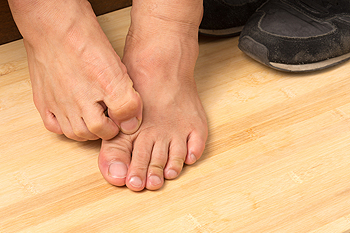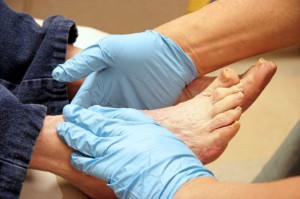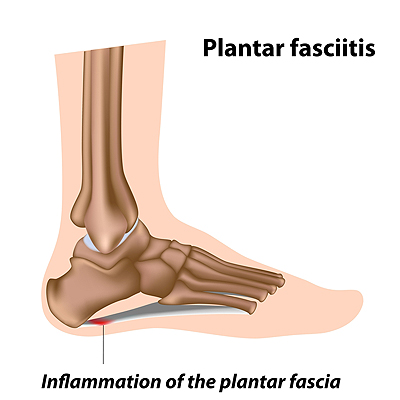 If you frequently wear flip-flops and find your feet aching, sore, or injured, you may be wondering if these staple summer shoes are to blame. Often, the answer is yes. Wearing flip-flops regularly can be very bad for your feet. Flip-flops offer no arch support, which can lead to pain in the heels, arches, balls of the feet, and toes. As you walk in flip-flops, you must bend your toes to keep the shoes on your feet. Over time, this can strain the muscles and joints of the feet and lead to discomfort, pain, and toe deformities such as hammertoe. Wearing flat shoes can also strain the Achilles tendon by overstretching the calf muscles. Flip-flops offer no protection to your feet from the elements, which can cause dry, cracked heels and injuries to your feet from things like rocks, sharp objects, and other people stepping on your feet. If you are experiencing foot or ankle pain, it is suggested that you see a podiatrist.
If you frequently wear flip-flops and find your feet aching, sore, or injured, you may be wondering if these staple summer shoes are to blame. Often, the answer is yes. Wearing flip-flops regularly can be very bad for your feet. Flip-flops offer no arch support, which can lead to pain in the heels, arches, balls of the feet, and toes. As you walk in flip-flops, you must bend your toes to keep the shoes on your feet. Over time, this can strain the muscles and joints of the feet and lead to discomfort, pain, and toe deformities such as hammertoe. Wearing flat shoes can also strain the Achilles tendon by overstretching the calf muscles. Flip-flops offer no protection to your feet from the elements, which can cause dry, cracked heels and injuries to your feet from things like rocks, sharp objects, and other people stepping on your feet. If you are experiencing foot or ankle pain, it is suggested that you see a podiatrist.
Flip-flops are not always the best choice of footwear. If you have any concerns about your feet or ankles, contact Bruce Smit, DPM from Frankfort Foot & Ankle Clinic. Our doctor will assist you with all of your foot and ankle needs.
Flip-Flops and Feet
When the weather starts warming up, people enjoy wearing flip-flops. Flip-flops are comfortable, stylish, and easy to slip on and off; they're perfect for any summer beach goer. However, these shoes can cause harm to the feet.
How Can Flip-Flops Affect Me Long-Term?
Are There Injuries Associated with Flip-Flops?
Yes. Since flip-flops are relatively weak and do not provide the same amount of support as sneakers, people who wear flip-flops regularly are more susceptible to injuries. On top of that, the open nature of the shoe makes your feet more prone to other problems, such as cuts and even infections. Common injuries and ailments include:
I like Wearing Flip-Flops. Are There Safe Alternatives?
When buying flip-flops, try to find ones that have sturdy soles and that are made of high-quality materials that will support for your feet. These flip-flops will cost more but will also last longer as a result.
If you have any questions please feel free to contact our office located in Frankfort, IL . We offer the newest diagnostic and treatment technologies for all your foot and ankle needs.
Taking good care of your feet not only reduces foot pain and your risk of foot injuries, but can also help prevent falls. Older people who take care of their feet are less likely to fall than those who don’t. Some of the things that you can do to maintain good foot health and prevent falls include wearing properly fitted shoes with a wider toe box, wearing shoes while indoors, and maintaining a healthy body weight. Having well-lit areas in your hallways and being aware of any tripping hazards can also help in the prevention of falls. Using over-the-counter orthotic inserts to cushion the feet and decrease foot pain may also reduce the risk of falling. To learn more about the link between foot health and falling, please consult with a podiatrist.
Preventing falls among the elderly is very important. If you are older and have fallen or fear that you are prone to falling, consult with Bruce Smit, DPM from Frankfort Foot & Ankle Clinic. Our doctor will assess your condition and provide you with quality advice and care.
Every 11 seconds, an elderly American is being treated in an emergency room for a fall related injury. Falls are the leading cause of head and hip injuries for those 65 and older. Due to decreases in strength, balance, senses, and lack of awareness, elderly persons are very susceptible to falling. Thankfully, there are a number of things older persons can do to prevent falls.
How to Prevent Falls
Some effective methods that older persons can do to prevent falls include:
Falling can be a traumatic and embarrassing experience for elderly persons; this can make them less willing to leave the house, and less willing to talk to someone about their fears of falling. Doing such things, however, will increase the likelihood of tripping or losing one’s balance. Knowing the causes of falling and how to prevent them is the best way to mitigate the risk of serious injury.
If you have any questions, please feel free to contact our office located in Frankfort, IL . We offer the newest diagnostic and treatment technologies for all your foot care needs.
Ingrown toenails are often relatively harmless and heal on their own. Conservative treatment methods such as wearing roomier shoes and soaking the feet in warm water is usually enough to relieve pain and heal the nail. However, some ingrown toenails can be severe, become infected, or can frequently recur. In these cases, surgery may be suggested. Acute inflammation or infection may be treated by surgically removing a small portion of the ingrown nail. In very severe cases, where the toenail has become very deformed or severely infected, the entire nail may need to be removed. If you are prone to ingrown toenails, or have an ingrown nail that you suspect is infected, please consult with a podiatrist to find the right treatment for you.
Ingrown toenails can become painful if they are not treated properly. For more information about ingrown toenails, contact Bruce Smit, DPM of Frankfort Foot & Ankle Clinic. Our doctor can provide the care you need to keep you pain-free and on your feet.
Ingrown Toenails
Ingrown toenails occur when a toenail grows sideways into the bed of the nail, causing pain, swelling, and possibly infection.
Causes
Prevention
Because ingrown toenails are not something found outside of shoe-wearing cultures, going barefoot as often as possible will decrease the likeliness of developing ingrown toenails. Wearing proper fitting shoes and using proper cutting techniques will also help decrease your risk of developing ingrown toenails.
Treatment
Ingrown toenails are a very treatable foot condition. In minor cases, soaking the affected area in salt or antibacterial soaps will not only help with the ingrown nail itself, but also help prevent any infections from occurring. In more severe cases, surgery is an option. In either case, speaking to your podiatrist about this condition will help you get a better understanding of specific treatment options that are right for you.
If you have any questions please feel free to contact our office located in Frankfort, IL . We offer the newest diagnostic and treatment technologies for all your foot and ankle needs.
 A rash on the foot may be athlete’s foot. It is an uncomfortable foot condition that is caused by a fungus. Common symptoms many patients experience can include severe itchiness on the bottom of the foot and between the toes, a burning sensation, and possible blisters. The type of fungus that causes this ailment lives in warm and moist environments, and is considered to be contagious. Common places the fungi may spread include public swimming pools, shower room floors, and locker rooms. It is advisable to wear appropriate shoes while in these areas, in addition to refraining from sharing towels, shoes, and socks. Mild relief may be attained when an antifungal powder is used, as this may help to alleviate a portion of the itching. If you are afflicted with athlete’s foot, please consult with a podiatrist who can offer you proper treatment solutions.
A rash on the foot may be athlete’s foot. It is an uncomfortable foot condition that is caused by a fungus. Common symptoms many patients experience can include severe itchiness on the bottom of the foot and between the toes, a burning sensation, and possible blisters. The type of fungus that causes this ailment lives in warm and moist environments, and is considered to be contagious. Common places the fungi may spread include public swimming pools, shower room floors, and locker rooms. It is advisable to wear appropriate shoes while in these areas, in addition to refraining from sharing towels, shoes, and socks. Mild relief may be attained when an antifungal powder is used, as this may help to alleviate a portion of the itching. If you are afflicted with athlete’s foot, please consult with a podiatrist who can offer you proper treatment solutions.
Athlete’s Foot
Athlete’s foot is often an uncomfortable condition to experience. Thankfully, podiatrists specialize in treating athlete’s foot and offer the best treatment options. If you have any questions about athlete’s foot, consult with Bruce Smit, DPM from Frankfort Foot & Ankle Clinic. Our doctor will assess your condition and provide you with quality treatment.
What Is Athlete’s Foot?
Tinea pedis, more commonly known as athlete’s foot, is a non-serious and common fungal infection of the foot. Athlete’s foot is contagious and can be contracted by touching someone who has it or infected surfaces. The most common places contaminated by it are public showers, locker rooms, and swimming pools. Once contracted, it grows on feet that are left inside moist, dark, and warm shoes and socks.
Prevention
The most effective ways to prevent athlete’s foot include:
Symptoms
Athlete’s foot initially occurs as a rash between the toes. However, if left undiagnosed, it can spread to the sides and bottom of the feet, toenails, and if touched by hand, the hands themselves. Symptoms include:
Diagnosis and Treatment
Diagnosis is quick and easy. Skin samples will be taken and either viewed under a microscope or sent to a lab for testing. Sometimes, a podiatrist can diagnose it based on simply looking at it. Once confirmed, treatment options include oral and topical antifungal medications.
If you have any questions, please feel free to contact our office located in Frankfort, IL . We offer the newest diagnostic and treatment technologies for all your foot care needs.
The fifth metatarsal bone—the long bone connected to the little toe on the outside of the foot—is prone to breaks, with the two most common being Avulsion fractures and Jones fractures. Avulsion fractures usually occur from an injury that causes tendons or ligaments to pull a portion of the bone away from itself. A Jones fracture is less common, occurs either over time or suddenly, is harder to treat, and takes longer to heal due to less blood flow to the area. People suffering from either type of fifth metatarsal fracture can experience bruising or discomfort along the outside of the foot including tenderness, swelling, and pain. Some may even have difficulty walking. A podiatrist can properly diagnose the type of break and use several types of therapies and procedures to facilitate healing.
A broken foot requires immediate medical attention and treatment. If you need your feet checked, contact Bruce Smit, DPM from Frankfort Foot & Ankle Clinic. Our doctor can provide the care you need to keep you pain-free and on your feet.
Broken Foot Causes, Symptoms, and Treatment
A broken foot is caused by one of the bones in the foot typically breaking when bended, crushed, or stretched beyond its natural capabilities. Usually the location of the fracture indicates how the break occurred, whether it was through an object, fall, or any other type of injury.
Common Symptoms of Broken Feet:
Those that suspect they have a broken foot shoot seek urgent medical attention where a medical professional could diagnose the severity.
Treatment for broken bones varies depending on the cause, severity and location. Some will require the use of splints, casts or crutches while others could even involve surgery to repair the broken bones. Personal care includes the use of ice and keeping the foot stabilized and elevated.
If you have any questions please feel free to contact our office located in Frankfort, IL . We offer the newest diagnostic and treatment technologies for all your foot and ankle needs.
The Achilles tendon is a collection of fibrous tissues that connect the heel bone to the calf muscles. This tendon is responsible for our ability to walk, run, and jump, but it is very vulnerable to injury from athletic activities that put excess strain on the tendon. The three most common types of Achilles tendon injuries are an Achilles tendon tear, an Achilles tendon rupture, and Achilles tendonitis. An Achilles tendon tear, in which the tendon tears slightly, is characterized by intense pain, swelling, and difficulty moving the affected ankle. An Achilles tendon rupture, in which the tendon tears completely, may make a popping or snapping sound at the time of injury, cause severe pain, and make walking extremely difficult. Achilles tendonitis is an inflammation of the Achilles tendon. It usually causes burning pain in the calf and heel that intensifies during physical activity. If you have injured your Achilles tendon, it is suggested that you seek the care of a podiatrist.
Achilles tendon injuries need immediate attention to avoid future complications. If you have any concerns, contact Bruce Smit, DPM of Frankfort Foot & Ankle Clinic. Our doctor can provide the care you need to keep you pain-free and on your feet.
What Is the Achilles Tendon?
The Achilles tendon is a tendon that connects the lower leg muscles and calf to the heel of the foot. It is the strongest tendon in the human body and is essential for making movement possible. Because this tendon is such an integral part of the body, any injuries to it can create immense difficulties and should immediately be presented to a doctor.
What Are the Symptoms of an Achilles Tendon Injury?
There are various types of injuries that can affect the Achilles tendon. The two most common injuries are Achilles tendinitis and ruptures of the tendon.
Achilles Tendinitis Symptoms
Rupture Symptoms
Treatment and Prevention
Achilles tendon injuries are diagnosed by a thorough physical evaluation, which can include an MRI. Treatment involves rest, physical therapy, and in some cases, surgery. However, various preventative measures can be taken to avoid these injuries, such as:
If you have any questions please feel free to contact our office located in Frankfort, IL . We offer the newest diagnostic tools and technology to treat your foot and ankle needs.
 Diabetes is a disease that affects your blood sugar - so how can this condition affect the feet, too? The prolonged episodes of high blood sugar that are characteristic of diabetes often cause damage to the blood vessels throughout your body, including those that supply your lower limbs. Poor blood flow to the feet can lead to complications such as poorly healing wounds and a loss of sensation. Diabetes is associated with multiple conditions that affect the feet, including diabetic neuropathy, Charcot foot, peripheral artery disease, and gangrene. Signs of diabetes affecting the feet include swelling, tingling, numbness, weakness, skin discoloration, and foot wounds, among many others. If you have diabetes, it is suggested that you are under the care of a podiatrist, who can help you manage any foot-related symptoms.
Diabetes is a disease that affects your blood sugar - so how can this condition affect the feet, too? The prolonged episodes of high blood sugar that are characteristic of diabetes often cause damage to the blood vessels throughout your body, including those that supply your lower limbs. Poor blood flow to the feet can lead to complications such as poorly healing wounds and a loss of sensation. Diabetes is associated with multiple conditions that affect the feet, including diabetic neuropathy, Charcot foot, peripheral artery disease, and gangrene. Signs of diabetes affecting the feet include swelling, tingling, numbness, weakness, skin discoloration, and foot wounds, among many others. If you have diabetes, it is suggested that you are under the care of a podiatrist, who can help you manage any foot-related symptoms.
Diabetic foot care is important in preventing foot ailments such as ulcers. If you are suffering from diabetes or have any other concerns about your feet, contact Bruce Smit, DPM from Frankfort Foot & Ankle Clinic. Our doctor can provide the care you need to keep you pain-free and on your feet.
Diabetic Foot Care
Diabetes affects millions of people every year. The condition can damage blood vessels in many parts of the body, especially the feet. Because of this, taking care of your feet is essential if you have diabetes, and having a podiatrist help monitor your foot health is highly recommended.
The Importance of Caring for Your Feet
Patients with diabetes should have their doctor monitor their blood levels, as blood sugar levels play such a huge role in diabetic care. Monitoring these levels on a regular basis is highly advised.
It is always best to inform your healthcare professional of any concerns you may have regarding your feet, especially for diabetic patients. Early treatment and routine foot examinations are keys to maintaining proper health, especially because severe complications can arise if proper treatment is not applied.
If you have any questions please feel free to contact our office located in Frankfort, IL . We offer the newest diagnostic and treatment technologies for all your foot and ankle needs.
 Plantar fasciitis is a condition in which the plantar fascia, a ligament that runs along the bottom of the foot, becomes injured, inflamed, and painful. Plantar fasciitis has a variety of causes, including spending too much time on your feet, engaging in high-impact repetitive activities like running, and wearing improper shoes that do not adequately support the foot. Plantar fasciitis can be treated conservatively by taking nonsteroidal anti-inflammatory medications to manage pain, stretching the feet each day, resting the feet regularly, massaging the feet, and wearing comfortable, supportive shoes. If you have plantar fasciitis, it is recommended that you see a podiatrist for treatment.
Plantar fasciitis is a condition in which the plantar fascia, a ligament that runs along the bottom of the foot, becomes injured, inflamed, and painful. Plantar fasciitis has a variety of causes, including spending too much time on your feet, engaging in high-impact repetitive activities like running, and wearing improper shoes that do not adequately support the foot. Plantar fasciitis can be treated conservatively by taking nonsteroidal anti-inflammatory medications to manage pain, stretching the feet each day, resting the feet regularly, massaging the feet, and wearing comfortable, supportive shoes. If you have plantar fasciitis, it is recommended that you see a podiatrist for treatment.
Plantar fasciitis can be very painful and inconvenient. If you are experiencing heel pain or symptoms of plantar fasciitis, contact Bruce Smit, DPM from Frankfort Foot & Ankle Clinic. Our doctor can provide the care you need to keep you pain-free and on your feet.
What Is Plantar Fasciitis?
Plantar fasciitis is the inflammation of the thick band of tissue that runs along the bottom of your foot, known as the plantar fascia, and causes mild to severe heel pain.
What Causes Plantar Fasciitis?
How Can It Be Treated?
While very treatable, plantar fasciitis is definitely not something that should be ignored. Especially in severe cases, speaking to your doctor right away is highly recommended to avoid complications and severe heel pain. Your podiatrist can work with you to provide the appropriate treatment options tailored to your condition.
If you have any questions please feel free to contact our office located in Frankfort, IL . We offer the newest diagnostic and treatment technologies for all your foot and ankle needs.